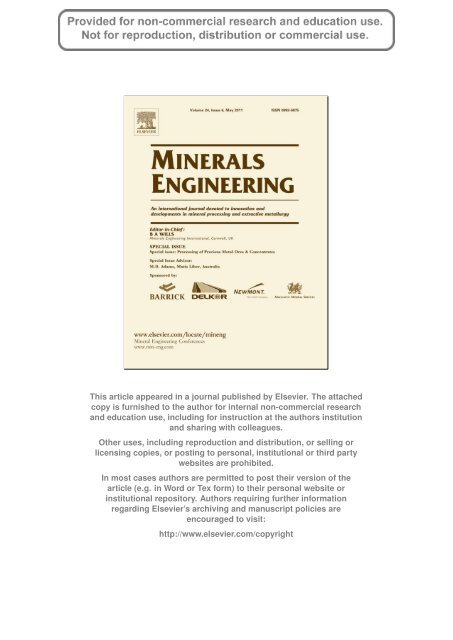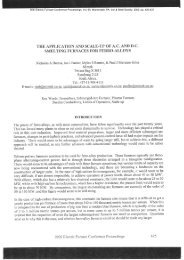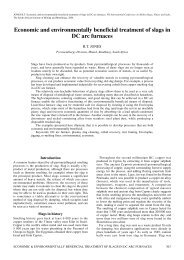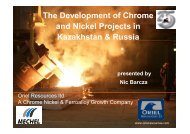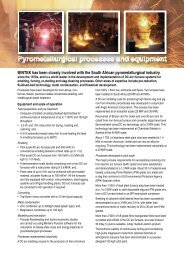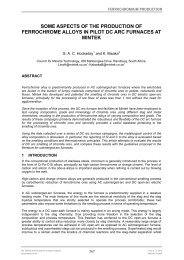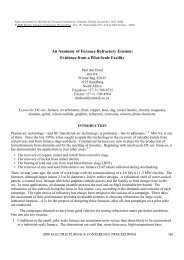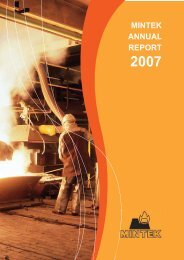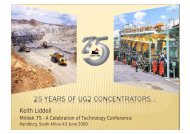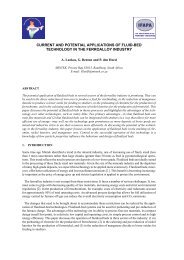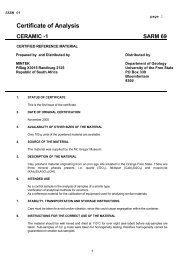This article appeared in a journal published by Elsevier ... - Mintek
This article appeared in a journal published by Elsevier ... - Mintek
This article appeared in a journal published by Elsevier ... - Mintek
You also want an ePaper? Increase the reach of your titles
YUMPU automatically turns print PDFs into web optimized ePapers that Google loves.
<strong>This</strong> <strong>article</strong> <strong>appeared</strong> <strong>in</strong> a <strong>journal</strong> <strong>published</strong> <strong>by</strong> <strong>Elsevier</strong>. The attached<br />
copy is furnished to the author for <strong>in</strong>ternal non-commercial research<br />
and education use, <strong>in</strong>clud<strong>in</strong>g for <strong>in</strong>struction at the authors <strong>in</strong>stitution<br />
and shar<strong>in</strong>g with colleagues.<br />
Other uses, <strong>in</strong>clud<strong>in</strong>g reproduction and distribution, or sell<strong>in</strong>g or<br />
licens<strong>in</strong>g copies, or post<strong>in</strong>g to personal, <strong>in</strong>stitutional or third party<br />
websites are prohibited.<br />
In most cases authors are permitted to post their version of the<br />
<strong>article</strong> (e.g. <strong>in</strong> Word or Tex form) to their personal website or<br />
<strong>in</strong>stitutional repository. Authors requir<strong>in</strong>g further <strong>in</strong>formation<br />
regard<strong>in</strong>g <strong>Elsevier</strong>’s archiv<strong>in</strong>g and manuscript policies are<br />
encouraged to visit:<br />
http://www.elsevier.com/copyright
Author's personal copy<br />
M<strong>in</strong>erals Eng<strong>in</strong>eer<strong>in</strong>g 24 (2011) 495–498<br />
Contents lists available at ScienceDirect<br />
M<strong>in</strong>erals Eng<strong>in</strong>eer<strong>in</strong>g<br />
<strong>journal</strong> homepage: www.elsevier.com/locate/m<strong>in</strong>eng<br />
The pros and cons of reductive matte smelt<strong>in</strong>g for PGMs<br />
R.T. Jones ⇑ , I.J. Geldenhuys<br />
Pyrometallurgy Division, M<strong>in</strong>tek, Private Bag X3015, Randburg 2125, South Africa<br />
<strong>article</strong><br />
<strong>in</strong>fo<br />
abstract<br />
Article history:<br />
Available onl<strong>in</strong>e 7 April 2011<br />
Keywords:<br />
Pyrometallurgy<br />
Extractive metallurgy<br />
Precious metal ores<br />
Reduction<br />
Roast<strong>in</strong>g<br />
Plat<strong>in</strong>um group metals (PGMs) are traditionally smelted <strong>in</strong> electric furnaces where the valuable metals<br />
are collected <strong>in</strong> a base-metal sulphide matte. An alternative to this process is the ConRoast process that<br />
uses reductive alloy smelt<strong>in</strong>g <strong>in</strong> a DC arc furnace to collect the valuable metals <strong>in</strong> an iron-rich alloy.<br />
Reductive smelt<strong>in</strong>g of feed materials conta<strong>in</strong><strong>in</strong>g PGMs, us<strong>in</strong>g carbon as a reduc<strong>in</strong>g agent, can be used<br />
to obta<strong>in</strong> high PGM and base-metal recoveries and to ensure the solubility of chromium <strong>in</strong> slags.<br />
Based on work carried out <strong>in</strong> M<strong>in</strong>tek’s 3 MW DC arc furnace at throughputs of over 1000 tons per<br />
month, it was found that PGMs could be collected effectively, and that the chromium problem could<br />
be managed. However, if matte is present <strong>in</strong> the furnace, there rema<strong>in</strong>s a significant risk of furnace failure.<br />
Furthermore, the PGM ‘lockup’ (<strong>in</strong>ventory <strong>in</strong>side the furnace) <strong>in</strong> a process that used reductive matte<br />
smelt<strong>in</strong>g of UG2 concentrates was much greater than that of reductive alloy smelt<strong>in</strong>g. Further differences<br />
exist <strong>in</strong> the better work<strong>in</strong>g environment and lower emissions of SO 2 <strong>in</strong> the case of the ConRoast process.<br />
Ó 2011 <strong>Elsevier</strong> Ltd. All rights reserved.<br />
1. Introduction<br />
Matte smelt<strong>in</strong>g <strong>in</strong> an electric furnace has been the established<br />
route for the treatment of PGM (plat<strong>in</strong>um group metals) ore concentrates<br />
s<strong>in</strong>ce 1969, when the six-<strong>in</strong>-l<strong>in</strong>e furnace took over from<br />
the blast furnace. The separation of the base-metal sulphides<br />
(form<strong>in</strong>g the PGM-conta<strong>in</strong><strong>in</strong>g matte) from the oxide m<strong>in</strong>erals<br />
(which make up the slag) is essentially a simple melt<strong>in</strong>g operation.<br />
Mostert and Roberts (1973) expla<strong>in</strong>ed that the reasons for mov<strong>in</strong>g<br />
away from the blast furnace <strong>in</strong>cluded the labour-<strong>in</strong>tensive nature<br />
of the smelt<strong>in</strong>g operation, the ris<strong>in</strong>g price of coke, and the changes<br />
<strong>in</strong> legislation regard<strong>in</strong>g gaseous emissions. The <strong>in</strong>troduction of<br />
anti-pollution laws meant that it would be costly to control the<br />
emission of a very large volume of gas conta<strong>in</strong><strong>in</strong>g between 1%<br />
and 2% sulphur dioxide that resulted from the typical concentrate<br />
of that era conta<strong>in</strong><strong>in</strong>g 15% Fe, 6% Ni + Cu, 8.5–10% S, and<br />
110–150 g/t PGMs.<br />
The products of PGM m<strong>in</strong><strong>in</strong>g today look very different from<br />
those of 40 years ago, and process changes are required <strong>in</strong> the<br />
smelt<strong>in</strong>g of PGM ore concentrates <strong>in</strong> order to accommodate the<br />
<strong>in</strong>creas<strong>in</strong>g amounts of UG2 concentrates that are be<strong>in</strong>g produced<br />
<strong>in</strong> the South African Bushveld Complex. These concentrates conta<strong>in</strong><br />
much higher levels of chromium oxides and much lower levels of<br />
base-metal sulphides than the previously typical concentrates<br />
from the Merensky reef.<br />
⇑ Correspond<strong>in</strong>g author. Tel.: +27 11 709 4602.<br />
E-mail address: rtjones@global.co.za (R.T. Jones).<br />
The ConRoast process, previously described <strong>by</strong> Jones (2002)<br />
Jones (2009), is an alternative to matte smelt<strong>in</strong>g that does not<br />
require sulphur to collect the valuable metals, but <strong>in</strong>stead collects<br />
the PGMs and base metals <strong>in</strong> an iron-rich alloy. <strong>This</strong> proposed<br />
solution to the problem of smelt<strong>in</strong>g UG2 (and other) concentrates<br />
<strong>in</strong>volves roast<strong>in</strong>g of the concentrates to remove most of the sulphur<br />
prior to smelt<strong>in</strong>g, followed <strong>by</strong> reductive alloy smelt<strong>in</strong>g <strong>in</strong> a<br />
DC arc furnace. <strong>This</strong> process is unconstra<strong>in</strong>ed <strong>by</strong> the amount of<br />
chromium present <strong>in</strong> the feed, is much environmentally cleaner<br />
<strong>in</strong> terms of sulphur emissions, is much less prone to failure of furnace<br />
conta<strong>in</strong>ment, and achieves very high recoveries of PGMs. The<br />
result<strong>in</strong>g alloy can be treated further either hydrometallurgically,<br />
or pyrometallurgically <strong>by</strong> convert<strong>in</strong>g to remove the iron to produce<br />
a product very similar to a conventional converter matte.<br />
The challenges fac<strong>in</strong>g PGM smelters today can be summarised<br />
<strong>in</strong> terms of three major problems.<br />
1.1. The sulphur problem<br />
The emission of SO 2 (sulphur dioxide) from furnaces and<br />
converters is hard to avoid when us<strong>in</strong>g a sulphur-based mattesmelt<strong>in</strong>g<br />
process. However, the ConRoast process does not rely<br />
on the presence of sulphur, as it smelts essentially sulphur-free<br />
(or low-sulphur) material <strong>in</strong> a DC arc furnace and collects the<br />
valuable metals <strong>in</strong> an iron alloy. Sulphur can be removed, prior<br />
to smelt<strong>in</strong>g, us<strong>in</strong>g a fluidized-bed roaster which is a well-enclosed<br />
vessel that produces a steady cont<strong>in</strong>uous stream of SO 2 that can be<br />
used for the production of sulphuric acid (if the concentration and<br />
scale warrant this course of action). Compared to the traditional<br />
matte-smelt<strong>in</strong>g process, emissions of SO 2 can be orders of magni-<br />
0892-6875/$ - see front matter Ó 2011 <strong>Elsevier</strong> Ltd. All rights reserved.<br />
doi:10.1016/j.m<strong>in</strong>eng.2011.03.007
Author's personal copy<br />
496 R.T. Jones, I.J. Geldenhuys / M<strong>in</strong>erals Eng<strong>in</strong>eer<strong>in</strong>g 24 (2011) 495–498<br />
tude lower if the ConRoast process is used. The capital costs of acid<br />
production can also be reduced markedly.<br />
1.2. The chromium problem<br />
The traditional matte-smelt<strong>in</strong>g process imposes strict limits on<br />
the quantity of chromite (prevalent <strong>in</strong> the UG2 reef) that can be<br />
present <strong>in</strong> the smelter feed, because of the deleterious consequences<br />
of build-ups of the very stable crystall<strong>in</strong>e chrome sp<strong>in</strong>el<br />
<strong>in</strong> the furnace. <strong>This</strong> constra<strong>in</strong>t restricts the recovery of the PGMs<br />
<strong>in</strong> the production of ore concentrates. The ConRoast process elim<strong>in</strong>ates<br />
the chromium constra<strong>in</strong>t <strong>in</strong> smelt<strong>in</strong>g and so opens up huge<br />
opportunities <strong>in</strong> the types of materials that can be smelted, and provides<br />
an opportunity to significantly enhance the overall process<br />
recovery of PGMs (through remov<strong>in</strong>g the restrictions <strong>in</strong> concentrator<br />
operations). The essential step <strong>in</strong> the solution of the chromium<br />
problem <strong>in</strong>volves the addition to the furnace of carbon as a reductant,<br />
to ensure that the oxidation state of the chromium changes<br />
from that of Cr 2 O 3 to that of CrO, which is readily soluble <strong>in</strong> the slag.<br />
1.3. The conta<strong>in</strong>ment problem<br />
As the South African plat<strong>in</strong>um producers have moved <strong>in</strong>creas<strong>in</strong>gly<br />
to process<strong>in</strong>g ore from the UG2 reef to supplement the previous<br />
production from the Merensky reef, there have been numerous<br />
furnace failures and explosions <strong>in</strong> the <strong>in</strong>dustry. Increas<strong>in</strong>g smelt<strong>in</strong>g<br />
temperatures have been used <strong>in</strong> an attempt to avoid the build-up<br />
of chrome sp<strong>in</strong>el emanat<strong>in</strong>g from the higher Cr 2 O 3 contents <strong>in</strong><br />
UG2 concentrates. Even though water-cooled copper cool<strong>in</strong>g systems<br />
have been <strong>in</strong>troduced <strong>in</strong> recent years, the highly superheated<br />
and corrosive molten matte <strong>in</strong> traditional smelters is <strong>in</strong>herently<br />
difficult to conta<strong>in</strong>. The CEO of one of the major plat<strong>in</strong>um producers<br />
was recently quoted <strong>by</strong> Hasell (2010) as describ<strong>in</strong>g the company’s<br />
largest furnace as ‘‘particularly unreliable’’. On the other<br />
hand, the ConRoast process is able to use a simple and robust design<br />
of furnace, because the melt<strong>in</strong>g temperatures of the slag and<br />
alloy are close to each other.<br />
The two processes briefly described above, namely matte smelt<strong>in</strong>g<br />
and reductive alloy smelt<strong>in</strong>g, are very different from each<br />
other, as are the types of furnace <strong>in</strong> which they are typically carried<br />
out. The question has often been asked whether it would make<br />
sense to use a hybrid of these two approaches, namely reductive<br />
matte smelt<strong>in</strong>g, where carbon is used as a reductant, but the product<br />
from the furnace rema<strong>in</strong>s a sulphide matte. <strong>This</strong> paper is aimed<br />
at answer<strong>in</strong>g that question, at least <strong>in</strong> part.<br />
3. Pilot-scale testwork<br />
Large-scale demonstration smelt<strong>in</strong>g of PGM-conta<strong>in</strong><strong>in</strong>g feed<br />
materials has been carried out <strong>in</strong> M<strong>in</strong>tek’s pilot plant s<strong>in</strong>ce April<br />
2004. The DC arc furnaces that were used for the testwork were<br />
l<strong>in</strong>ed with refractory bricks similar to those used <strong>in</strong> conventional<br />
matte smelt<strong>in</strong>g furnaces, although the hearth design of the DC<br />
arc furnace is quite different. Much of this work <strong>in</strong>volved the<br />
process<strong>in</strong>g of revert tail<strong>in</strong>gs that had a low sulphur content, as<br />
described <strong>by</strong> Geldenhuys et al. (2009). <strong>This</strong> <strong>in</strong>itial work, carried<br />
out <strong>in</strong> a 1.5 MW DC arc furnace with a shell diameter of 3 m, is<br />
used as a reference po<strong>in</strong>t for the comparison of more recent<br />
furnace campaigns.<br />
The reductive matte-smelt<strong>in</strong>g work described here covers two<br />
roughly 6-month periods of operation of M<strong>in</strong>tek’s 3 MW DC arc<br />
furnace, which has a shell diameter of 4.25 m.<br />
It was common practice dur<strong>in</strong>g the two reductive matte-smelt<strong>in</strong>g<br />
campaigns to work with a blend of feed materials, typically<br />
somewhere around a 75:25 mixture of various high-chromium<br />
concentrates to converter slag. The converter slag provided a convenient<br />
supplementary source of iron for the process, and resulted<br />
<strong>in</strong> an overall slag composition that was acceptable <strong>in</strong> terms of liquidus<br />
temperature and viscosity, and was not overly aggressive.<br />
The compositions of the blended feed for each of the campaigns<br />
are shown <strong>in</strong> Table 1. The compositions of the slag and alloy (or<br />
matte) products are shown <strong>in</strong> Tables 2 and 3. In these tables, the<br />
sections marked ‘Alloy smelt<strong>in</strong>g’ refer to the work that was extensively<br />
reported on <strong>by</strong> Geldenhuys et al. (2009), where the material<br />
smelted over the period May 2004 to August 2008 was revert<br />
tail<strong>in</strong>gs.<br />
It should be noted that, both for reductive alloy smelt<strong>in</strong>g and<br />
reductive matte smelt<strong>in</strong>g <strong>in</strong> a DC arc furnace, it is possible to vary<br />
the degree of reduction of the iron oxide <strong>in</strong> the feed to metallic<br />
iron. The recoveries of the valuable metals are directly l<strong>in</strong>ked to<br />
the extent to which iron oxide is reduced to the metallic state.<br />
Clearly, the mass of the alloy (or matte) that is produced <strong>in</strong> the furnace<br />
is also directly l<strong>in</strong>ked to the extent of iron recovery to the alloy.<br />
<strong>This</strong> allows the operator of the furnace significant flexibility to<br />
choose the desired operat<strong>in</strong>g po<strong>in</strong>t, and allows a trade-off to be<br />
made between the recovery of the valuable metals and the<br />
quantity of alloy that is produced (which then needs to be treated<br />
further). In light of this, not too much should be read <strong>in</strong>to the variations<br />
between the residual PGM contents of the slags listed below,<br />
as these figures simply reflect the operat<strong>in</strong>g choices that were<br />
preferred (or specified <strong>by</strong> the client) at the time.<br />
2. Reductive matte smelt<strong>in</strong>g<br />
Addition of carbon to PGM-conta<strong>in</strong><strong>in</strong>g concentrate <strong>in</strong> a furnace<br />
results <strong>in</strong> some of the iron (and other metallic) oxides be<strong>in</strong>g reduced<br />
to the metallic state. To some degree, the chromium oxides<br />
from UG2 concentrates will be reduced to CrO, there<strong>by</strong> becom<strong>in</strong>g<br />
more readily soluble <strong>in</strong> the slag. These advantages are similar to<br />
those enjoyed <strong>by</strong> the ConRoast process (where sulphur is removed<br />
<strong>in</strong> a fluidized-bed roaster prior to smelt<strong>in</strong>g, and the PGMs<br />
are collected <strong>in</strong> an iron-rich alloy), yet there are significant differences<br />
between ‘reductive matte smelt<strong>in</strong>g’ and ‘reductive alloy<br />
smelt<strong>in</strong>g’.<br />
Reductive matte smelt<strong>in</strong>g is constra<strong>in</strong>ed to produce a sulphurrich<br />
matte product, either for reasons of crushability or for compatibility<br />
with an exist<strong>in</strong>g downstream process. <strong>This</strong> negates the<br />
advantage of the alloy hav<strong>in</strong>g a high liquidus (melt<strong>in</strong>g) temperature<br />
that is compatible with that of the slag; and there is considerably<br />
higher risk of the super-heated matte penetrat<strong>in</strong>g the<br />
refractories and break<strong>in</strong>g out of the furnace.<br />
3.1. Campaign 1: October 2008–March 2009<br />
The first campaign <strong>in</strong> the then-new 3 MW furnace at M<strong>in</strong>tek<br />
started out with the <strong>in</strong>tention of do<strong>in</strong>g alloy smelt<strong>in</strong>g, as before.<br />
However, a serious challenge occurred as a result of feed materials<br />
arriv<strong>in</strong>g with too high a sulphur content. <strong>This</strong> resulted <strong>in</strong> the formation<br />
of an alloy with a much lower liquidus temperature than<br />
the process is designed to accommodate. The superheated alloy<br />
then caused rapid wear of the side-wall refractories, result<strong>in</strong>g <strong>in</strong><br />
a leak adjacent to the alloy tap-hole on 27 March 2009. The escap<strong>in</strong>g<br />
stream of superheated molten alloy cut through one of the<br />
cool<strong>in</strong>g circuits, result<strong>in</strong>g <strong>in</strong> a series of metal-water explosions just<br />
outside the furnace. <strong>This</strong> <strong>in</strong>cident was well managed and there<br />
were no <strong>in</strong>juries or burns, but it did cause a 3-week shutdown of<br />
the furnace while repairs were carried out. The <strong>in</strong>cident highlighted<br />
the benefits of operat<strong>in</strong>g <strong>in</strong> a low-sulphur alloy-smelt<strong>in</strong>g<br />
mode, as more than 4 years of previous <strong>in</strong>cident-free operation<br />
were starkly contrasted with a mere 6 months of operation <strong>in</strong><br />
high-sulphur mode. <strong>This</strong> clearly po<strong>in</strong>ted out the limitations of
Author's personal copy<br />
R.T. Jones, I.J. Geldenhuys / M<strong>in</strong>erals Eng<strong>in</strong>eer<strong>in</strong>g 24 (2011) 495–498 497<br />
Table 1<br />
Feed composition, mass% (PGM listed <strong>in</strong> g/t).<br />
Al 2 O 3 CaO Co Cr 2 O 3 Cu FeO MgO Ni S SiO 2 PGM 4e<br />
Alloy smelt<strong>in</strong>g 3.73 6.42 0.14 2.41 0.30 32.2 11.79 0.89 0.76 36.2 51<br />
October 2008–March 2009 5.17 3.85 0.13 2.45 0.66 24.54 14.26 1.34 1.53 40.46 74<br />
October 2009–March 2010 3.50 2.80 0.12 2.30 0.82 20.91 18.59 1.50 1.99 40.87 167<br />
Note: PGM 4e = Pt + Pd + Rh + Au.<br />
Table 2<br />
Slag composition, mass% (PGM listed <strong>in</strong> g/t).<br />
Al 2 O 3 CaO Co Cr 2 O 3 Cu FeO MgO Ni S SiO 2 PGM 4e<br />
Alloy smelt<strong>in</strong>g 4.41 7.27 0.05 2.83 0.09 28.7 14.06 0.11 0.34 41.3 1.12<br />
October 2008–March 2009 6.38 4.51 0.04 3.00 0.10 18.15 17.51 0.08 0.18 48.18 0.48<br />
October 2009–March 2010 4.15 3.11 0.06 2.59 0.15 20.70 20.96 0.19 0.28 45.81 1.70<br />
Table 3<br />
Alloy composition, mass% (PGM listed <strong>in</strong> g/t).<br />
C Co Cr Cu Fe Ni S Si PGM 4e<br />
Alloy smelt<strong>in</strong>g 0.07 1.40 0.17 3.18 77.0 10.8 6.05 0.24 662<br />
October 2008–March 2009 0.05 0.94 0.46 5.56 67.18 12.26 11.42 0.18 749<br />
October 2009–March 2010 0.04 0.83 0.30 10.42 46.31 20.18 19.13 0.17 1968<br />
high-sulphur feed materials, and the necessity for a full implementation<br />
of the ConRoast process <strong>in</strong>clud<strong>in</strong>g the roast<strong>in</strong>g step. It had<br />
been expedient to simply smelt the feed materials directly without<br />
first <strong>in</strong>stall<strong>in</strong>g a roaster, and this worked quite satisfactorily as long<br />
as the sulphur content of the feed was low.<br />
3.2. Campaign 2: October 2009–March 2010<br />
A second opportunity to try out reductive matte smelt<strong>in</strong>g <strong>in</strong> the<br />
3 MW DC arc furnace came about almost exactly a year after the<br />
first. <strong>This</strong> time there was a requirement to produce a crushable<br />
(rather than granulated) matte product from a range of high-sulphur<br />
feed materials.<br />
In order to produce a matte with a close-to-conventional composition,<br />
it was necessary to limit the amount of metallic iron that<br />
was produced <strong>by</strong> reduction of iron oxide. <strong>This</strong> imposed quite a constra<strong>in</strong>t<br />
on the operation, as it was also necessary to meet the need<br />
for high PGM recoveries.<br />
Because of the ever-present risk of furnace failure caused <strong>by</strong><br />
super-heated matte, it was prudent to operate the furnace at a lower<br />
power <strong>in</strong>tensity (about 60%) than was used for the alloy-based<br />
ConRoast process. In this case, a target throughput of 1200 tons<br />
per month was used, although constra<strong>in</strong>ts on the supply of feed<br />
material limited actual throughputs to around 1000 tons per<br />
month.<br />
The very high sulphur content of the matte resulted <strong>in</strong> it hav<strong>in</strong>g<br />
a very low liquidus temperature (relative to that of the slag). The<br />
superheated matte has a great propensity for penetrat<strong>in</strong>g the<br />
refractory l<strong>in</strong><strong>in</strong>g of the furnace. There was a marked difference between<br />
the alloy-smelt<strong>in</strong>g and matte-smelt<strong>in</strong>g operations, <strong>in</strong> terms<br />
of SO 2 emissions from the furnace, especially <strong>in</strong> the immediate<br />
work<strong>in</strong>g environment dur<strong>in</strong>g slag and matte tapp<strong>in</strong>g.<br />
A notable feature of this campaign is that a significant portion<br />
(around a quarter) of the PGMs seemed to stay beh<strong>in</strong>d <strong>in</strong> the furnace.<br />
<strong>This</strong> PGM ‘lockup’ (<strong>in</strong>ventory <strong>in</strong>side the furnace) cont<strong>in</strong>ued<br />
to <strong>in</strong>crease for a number of months. At the conclusion of this particular<br />
smelt<strong>in</strong>g contract, it was required to dig out the furnace<br />
contents because of the extensive ‘lockup’ of the valuable alloy/<br />
matte product which was believed to have penetrated the refractory<br />
l<strong>in</strong><strong>in</strong>g <strong>in</strong>clud<strong>in</strong>g the hearth. <strong>This</strong> dig-out work is currently<br />
Table 4<br />
Summary of ma<strong>in</strong> features of the furnace campaigns.<br />
Alloy<br />
smelt<strong>in</strong>g<br />
October<br />
2008–March<br />
2009<br />
October<br />
2009–March<br />
010<br />
Duration 4 years 6 months 6 months<br />
Tons smelted 37,000 6158 5793<br />
Highest tons/day 47.1<br />
(=1430 t/m)<br />
65.8<br />
(=2000 t/m)<br />
47.2<br />
(=1440 t/m)<br />
Mass of alloy/ 7.3 10.0 6.5<br />
mass<br />
of feed, %<br />
Mass of slag/ 84 82.0 94.2<br />
mass<br />
of feed, %<br />
%S <strong>in</strong> feed 0.76 1.53 1.99<br />
%S <strong>in</strong> alloy, 6.1 11.4 19.1<br />
average<br />
%S <strong>in</strong> alloy, N/A 15.6 23.9<br />
maximum<br />
%Cr 2 O 3 <strong>in</strong> feed 2.4 2.5 2.3<br />
Mass Cr <strong>in</strong> alloy/ 0.5–1.4 2.8 1.2<br />
mass<br />
of Cr <strong>in</strong> feed, %<br />
PGM recovery, % 99 99 99<br />
alloy/<br />
(alloy + slag)<br />
PGM retention <strong>in</strong><br />
furnace = 1<br />
((alloy + slag)/<br />
feed)<br />
Not directly<br />
comparable<br />
with other<br />
two<br />
campaigns<br />
2% 23%<br />
Furnace <strong>in</strong>tegrity<br />
Corrosion of<br />
steelwork<br />
SO 2 emissions<br />
from furnace<br />
No failures<br />
<strong>in</strong> 4 years of<br />
operation<br />
No<br />
significant<br />
corrosion<br />
Tap-hole<br />
leak after<br />
6 months<br />
Off-gas area<br />
Very low Significant High<br />
No failure, but extensive<br />
matte penetration of<br />
refractories<br />
Corroded upper side-walls<br />
and off-gas area<br />
underway, but it is very clear from a visual <strong>in</strong>spection of the furnace<br />
that the matte had penetrated the hearth refractory material<br />
(normally over one metre thick) almost all of the way to the bottom<br />
of the furnace. There was also evidence of matte penetration<br />
between refractory bricks <strong>in</strong> the side-walls.
Author's personal copy<br />
498 R.T. Jones, I.J. Geldenhuys / M<strong>in</strong>erals Eng<strong>in</strong>eer<strong>in</strong>g 24 (2011) 495–498<br />
3.3. Comparison of reductive alloy smelt<strong>in</strong>g and reductive matte<br />
smelt<strong>in</strong>g<br />
Some highlights of the comparison between the various campaigns<br />
are shown <strong>in</strong> Table 4. Most noteworthy is the <strong>in</strong>crease <strong>in</strong><br />
the sulphur content of the feed material, from 1.5% to 2.0% (compared<br />
to much lower average 0.76% S content <strong>in</strong> the previous<br />
4-year alloy-smelt<strong>in</strong>g series of campaigns). The higher-S feed<br />
resulted <strong>in</strong> alloys conta<strong>in</strong><strong>in</strong>g averages of 11% and 19% S<br />
(and a maximum of 24%) for the two reductive matte-smelt<strong>in</strong>g<br />
campaigns.<br />
4. Conclusions<br />
Testwork at M<strong>in</strong>tek has shown that reductive matte smelt<strong>in</strong>g <strong>in</strong><br />
a DC arc furnace is able to accommodate the smelt<strong>in</strong>g of highchromium<br />
feed materials <strong>by</strong> means of us<strong>in</strong>g carbon as a reductant<br />
to ensure the solubilisation of chromium oxide <strong>in</strong> the slag.<br />
However, because of the high sulphur content of the feed materials<br />
to the furnace, the major challenges of furnace <strong>in</strong>tegrity and<br />
sulphur emissions rema<strong>in</strong>, us<strong>in</strong>g this approach.<br />
The use of a smelt<strong>in</strong>g approach that is a hybrid of matte smelt<strong>in</strong>g<br />
and reductive alloy smelt<strong>in</strong>g is ak<strong>in</strong> to the idea of try<strong>in</strong>g to<br />
‘cross a chasm us<strong>in</strong>g small steps’. It is better to choose which side<br />
of the chasm you would like to be on and then to fully embrace all<br />
aspects of that option.<br />
The preferred solution to the problem of smelt<strong>in</strong>g UG2 concentrates<br />
<strong>in</strong>volves roast<strong>in</strong>g of the concentrates to remove most of the<br />
sulphur prior to smelt<strong>in</strong>g, followed <strong>by</strong> reductive alloy smelt<strong>in</strong>g <strong>in</strong> a<br />
DC arc furnace. <strong>This</strong> process is unconstra<strong>in</strong>ed <strong>by</strong> the amount of<br />
chromium present <strong>in</strong> the feed, is much environmentally cleaner<br />
<strong>in</strong> terms of sulphur emissions, is much less prone to failure of furnace<br />
conta<strong>in</strong>ment, and achieves very high recoveries of PGMs. The<br />
result<strong>in</strong>g alloy can be treated further either hydrometallurgically,<br />
or pyrometallurgically <strong>by</strong> convert<strong>in</strong>g to remove the iron to produce<br />
a product very similar to a conventional converter matte.<br />
Acknowledgements<br />
<strong>This</strong> paper is <strong>published</strong> <strong>by</strong> permission of M<strong>in</strong>tek. The assistance<br />
of many colleagues at M<strong>in</strong>tek, <strong>in</strong> particular Tom Curr, Glen Denton<br />
and Cornel Potgieter, is gratefully acknowledged.<br />
References<br />
Geldenhuys, I.J., Jones, R.T., 2009. Four years of DC arc smelt<strong>in</strong>g of PGM-conta<strong>in</strong><strong>in</strong>g<br />
oxide feed materials at M<strong>in</strong>tek. In: Nickel and Cobalt 2009: Advances <strong>in</strong> the<br />
Process<strong>in</strong>g of Nickel, Cobalt and PGMs us<strong>in</strong>g Pyrometallurgical Techniques, 48th<br />
Annual Conference of Metallurgists, Sudbury, Ontario, Canada, 23–26 August<br />
2009, pp. 415–427. .<br />
Hasell, N., 2010. Molten metal too hot to handle, Quotation <strong>by</strong> Farmer, I. Times<br />
Onl<strong>in</strong>e, 11 May 2010. .<br />
Jones, R.T., 2002. ConRoast: DC arc smelt<strong>in</strong>g of dead-roasted sulphide concentrates.<br />
In: Stephens, R.L., Sohn, H.Y. (Eds.), Third International Sulfide Smelt<strong>in</strong>g<br />
Symposium (Sulfide Smelt<strong>in</strong>g ’02), 17–21 February 2002, TMS Annual<br />
Meet<strong>in</strong>g. TMS (The M<strong>in</strong>erals, Metals, & Materials Society), Seattle,<br />
Wash<strong>in</strong>gton, USA, pp. 435–456. .<br />
Jones, R.T., 2009. Towards commercialisation of M<strong>in</strong>tek’s ConRoast process for<br />
plat<strong>in</strong>um smelt<strong>in</strong>g. In: Nickel and Cobalt 2009: Advances <strong>in</strong> the Process<strong>in</strong>g of<br />
Nickel, Cobalt and PGMs us<strong>in</strong>g Pyrometallurgical Techniques, 48th Annual<br />
Conference of Metallurgists, Sudbury, Ontario, Canada, 23–26 August<br />
2009, pp.159–168. .<br />
Mostert, J.C., Roberts, P.N., 1973. Electric smelt<strong>in</strong>g at Rustenburg Plat<strong>in</strong>um M<strong>in</strong>es<br />
Limited of nickel-copper concentrates conta<strong>in</strong><strong>in</strong>g plat<strong>in</strong>um-group metals. SAIMM<br />
Journal 73(9), 290–299. .


